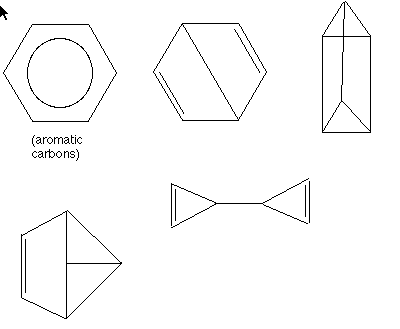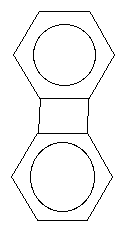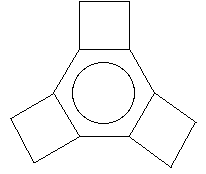
Aromaticity occurs when carbon forms bonds which are not exactly single or double, but rather are of intermediate length. The most common example of this is in benzene rings, C6H6. The six carbons are in a hexagonal arrangement, all in the same plane. There are two possible ways to draw this structure so that all of the valences are filled, using a combination of single and double bonds. These are shown below. Hydrogens are left off for convenience, and each of the corners is a carbon atom. Single lines are single bonds, double lines are double bonds. Because these two structures are forms of the same molecule, they are called "resonance structures". 
Count the bonds and satisfy yourself that, with the addition of six hydrogens, all of the carbons have full valences. However, now we have a different problem. Since there are two different structures drawn, how do we know which one is "really" the form for benzene? The answer is: neither!
This is where aromaticity comes in. Since the resonance structures are equally probable, benzene rings do not exist in exactly either state, but in a mixture of both. The bond lengths between carbons in a benzene ring are nearly halfway between the normal C-C and C=C bond lengths. This indicates that the electrons which would form the double bonds do not stay between any two carbons, but "float" or "delocalize" so that they spend equal amounts of time between all of the carbons. This makes all six bonds a little more than single bonds and a little less than single bonds. This delocalization makes these carbons "aromatic", that is, they exhibit aromaticity.
In this case study, you will investigate alternate forms for C6H6. You will demonstrate the added stability that aromaticity provides, and then look for evidence of aromaticity in other molecules incorporating benzene rings.
First, construct benzene and the theoretical molecule 1,3,5-cyclohexatriene. The latter is one of the resonance structures of benzene. Make three of the bonds double bonds and three single bonds. Optimize the geometries of both and conduct single-point energies. Why do you think 1,3,5-cyclohexatriene is a theoretical molecule (ie, has never been observed)? How stable is it compared to benzene? If time allows, compute electron density surfaces with electrostatic potential as a property, and compare the surfaces for the two molecules.
Construct the structures shown below. You should already have benzene. Minimize them and optimize their geometry.

Then perform single-point energy calculations, and make predictions about the stability of each isomer. Do you think that any of these have been observed?
Construct and optimize the two molecules below. Generate electron density surfaces for them with elpot as a property. Do you see evidence of aromaticity in these?
 |  |
| Biphyenlyene | Tricyclobutabenzene |
 The Shodor
Education Foundation, Inc.
The Shodor
Education Foundation, Inc.